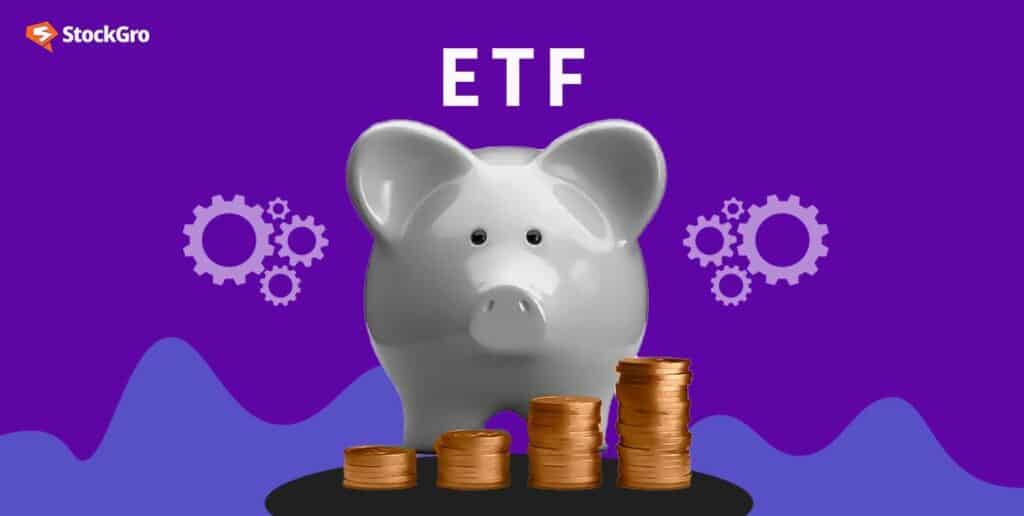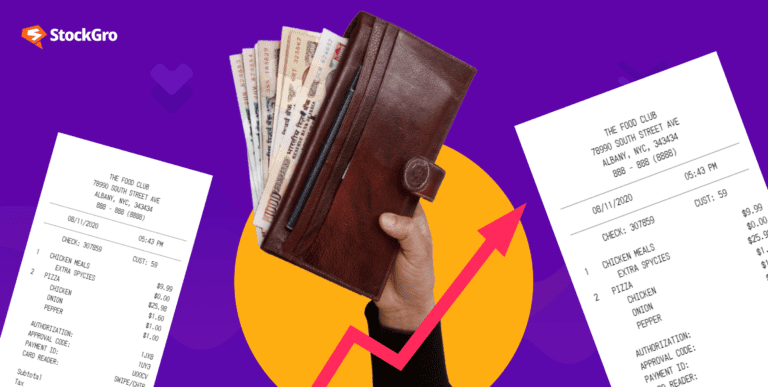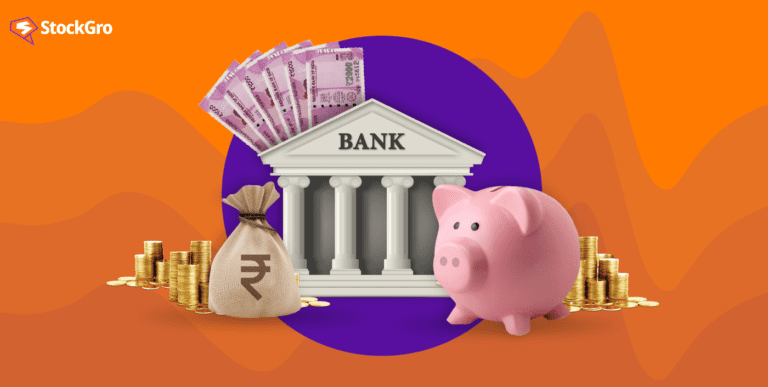
In 2001, Nippon India Mutual Fund, previously known as Reliance Mutual Fund, launched the first ETF in India. The Nifty 50 ETF, popularly known as “NiftyBees,” was the first of its kind and provided approximately 16% returns since its inception.
Two decades after the first one, over 150 Exchange traded fund are now listed on the NSE. Investors have various Exchange traded fund options to choose from, including those that invest overseas, follow factor-based investment strategies, invest in specific sectors or themes, and more.
So, let’s understand what they are and how they work.
What is an ETF?
An Exchange Traded Fund, or exchange-traded fund, is a unique investment vehicle combining diversification benefits of mutual funds with the simplicity of trading equities. Exchange traded fund are a type of investment fund that is traded on stock exchanges. Similar to mutual funds, Exchange traded fund pool money from multiple investors to purchase a basket of stocks, bonds, or other securities. Check out exchange traded funds vs mutual funds and how they stand against each other.
However, unlike mutual funds, they are traded like individual stocks and can be bought and sold throughout the day at market prices.
They generally have lower fees and are more easily traded than other types of funds, making them a popular choice for many investors.
Plus, they are super diverse. They can hold all kinds of investments, from stocks and bonds to commodities and real estate. So whether you’re interested in technology, energy, or something else entirely, there’s probably an ETF out there for you.
You may also like: How much is the Rupee worth across the globe?
Let’s understand with an example: You think India’s technology sector will boom, but you don’t have the time or expertise to pick individual tech stocks. Instead, you could buy shares of an Exchange traded fund that focuses on the Indian technology sector.
And the best part? You can buy and sell Exchange traded fund just like you would a regular stock. This makes them super easy to trade. So if you’re looking to invest in the stock market, but don’t want to bet on any one company or industry, consider checking out them.
How do ETFs work?
What makes them different from other investment funds is that they are designed to track specific indexes like the NIFTY 50 or SENSEX. They provide a number of advantages, including low cost, diversification, and liquidity.
The key difference between Exchange traded fund and a variety of funds is that they attempt to be the market rather than beat it. They simply replicate the performance of the Index they track.
Mechanics of ETFs
They are structured as open-ended mutual funds but trade like stocks. They are created and redeemed through a unique process that involves authorised participants (APs) and market makers.
Creation and redemption process
- APs create new exchange traded fund shares by buying a basket of stocks that represent the underlying index.
- The APs then transfer the basket of stocks to the exchange traded fund issuer in exchange for ETF shares.
- The exchange traded fund shares are then sold to investors on the stock exchange. When investors buy shares of an exchange traded fund on the exchange, they’re buying shares that represent a slice of the underlying basket held by the fund.
Role of Authorised Participants
Authorised participants are entities that have the authority to create and redeem exchange traded fund shares. They are typically large financial institutions or market makers that work with exchange traded fund issuers to keep the ETF price in line with its underlying net asset value (NAV).
Estimate your income tax payable under both tax regimes using the new income tax calculator for FY 2023-24
Advantages of ETFs
Flexibility of ETFs
Exchange traded fund shares also trade exactly like stocks, allowing for greater flexibility in buying, selling, or holding positions. They are priced and traded continuously throughout the trading hours, and they can be bought on margin, sold short, or held for the long term, exactly like common stock.
Passive Management
It is the chief distinguishing feature of exchange traded fund, which means the fund manager makes only minor, periodic adjustments to keep the fund in line with its index.
Passive management mitigates the element of “managerial risk” that can make choosing the right fund difficult. When you buy shares of an exchange traded fund, you are harnessing the power of the market itself, as opposed to investing in an ‘active’ fund managed by a fund manager.
Cost-Efficiency
They have lower administrative costs than actively managed portfolios since they track an index rather than attempting to outperform it.
Typical exchange traded fund administration costs are lower than those of an actively managed fund, coming in at less than 0.20% per year, compared to more than 1% for certain actively managed mutual fund schemes.
Risks of Investing in ETFs
While they have many advantages, they also have some drawbacks to consider. Just like a coin, there are two sides to the story. Let’s take a closer look at these potential downsides.
Illiquidity
Some exchange traded fund may have low trading volumes, making buying or selling shares at a fair price difficult. This can lead to significant bid-ask spreads, which can erode your returns over time.
Tracking Error
ETFs often mirror their underlying index closely. However, technical difficulties or market events might cause variances. These variations can cause significant differences between an exchange traded fund performance and its benchmark.
Best ETF for retirement
When you’re planning for retirement, it’s essential to choose an Exchange Traded Fund that offers stability, long-term growth, and low risk. Here are the top ten ETFs you should consider:
1. Nippon India Nifty 50 ETF: This Exchange Traded Fund tracks the Nifty 50 index and provides exposure to the top 50 companies listed on the NSE. It’s a good choice for stable, long-term growth.
- AUM: ₹34,093 cr.
- NAV: ₹278.3426
2. HDFC S&P BSE Sensex ETF: The HDFC Sensex ETF mirrors the performance of the BSE Sensex, making it an ideal choice for investors looking for exposure to India’s most established companies.
- AUM: ₹508.89 cr.
- NAV: ₹90.45
3. SBI ETF Nifty Next 50: This Exchange Traded Fund focuses on the next 50 large-cap companies after the Nifty 50 and offers diversification and potential for growth as these companies aim to join the top ranks.
- AUM:₹3,204 cr.
- NAV: ₹795.1006
4. ICICI Prudential Nifty 100 Low Volatility 30 ETF: Designed to invest in 30 low-volatility stocks from the Nifty 100, this ETF provides stability and consistent returns.
- AUM: ₹7,81,394 cr.
- NAV: ₹18.84
5. UTI Nifty 200 Momentum 30 ETF: The UTI Nifty 200 Momentum 30 ETF looks at companies within the Nifty 200 that exhibit high momentum. It caters to those looking for growth while maintaining a diversified exposure.
- AUM: ₹8,449.82 cr.
- NAV: ₹25.74
6. Kotak Gold ETF: Another great option for retirement, this Exchange Traded Fund gives access to gold, which acts as a hedge against inflation. It’s an essential addition for retirees looking to diversify their portfolios beyond equities.
- AUM: ₹4,39,120 cr.
- NAV: ₹31.08
7. Axis Nifty 100 ETF: This ETF gives exposure to the top 100 companies in India, combining stability and diversification for retirement.
- AUM: ₹2,92,314 cr.
- NAV: ₹22.96
8. Aditya Birla Sun Life Nifty 50 ETF: Another option tracking the Nifty 50, Aditya Birla Sun Life Nifty 50 ETF offers a simple way to gain exposure to India’s leading companies with low costs.
- AUM: ₹2,815 cr.
- NAV: ₹28.63
9. Motilal Oswal Nasdaq 100 ETF: This Exchange Traded Fund allows Indian investors to invest in the Nasdaq 100 and adds global tech companies to your portfolio. It is ideal for those seeking international exposure.
- AUM: ₹5,035.16 cr.
- NAV: ₹165.95
10. ICICI Prudential BSE Liquid Rate ETF: A good option for those looking for short-term stability. This ETF invests in money market instruments, making it a low-risk choice.
- AUM: ₹7,81,394 cr.
- NAV: ₹371.45
You should always evaluate risk tolerance and investment goals before selecting an Exchange Traded Fund for retirement. These ETFs have shown strong returns over the years and make for an ideal option for building a retirement portfolio.
Difference between mutual fund and ETF
| Criteria | Mutual Funds | ETFs |
| Trading | Priced once daily at NAV. This NAV is considered for a transaction during the day. | You can buy and sell them like other stocks. |
| Management | Actively managed, fund managers select securities. | Typically passively managed, track indexes like NIFTY 50. |
| Expense Ratios | Generally higher, ranging from 0.5% to 2%. | Lower, often below 0.2%, due to passive management. |
| Flexibility | Less flexible; limited to end-of-day trading. | Highly flexible; allows for strategies like short selling. |
| Tax Efficiency | Less tax-efficient due to frequent trading by managers. | More tax-efficient as fewer internal trades reduce capital gains taxes. |
| Investment Strategy | Often aims to outperform the market. | Aims to match index performance. |
| Liquidity | Less liquid as units can only be sold back to the fund. | Highly liquid as they can be traded easily on exchanges. |
| Cost Structure | Includes management fees, load fees, and other costs. | Usually has a simple, low-cost structure focused on tracking fees. |
Types of ETFs and how each works
They are designed to cater to specific investment focuses, and some of the most popular ones are:
Active Equity ETFs
Active Equity exchange traded fund allow managers to use their judgment when purchasing investments instead of solely focusing on a benchmark index. Although they may outperform the market benchmark, they come with higher risks and greater costs associated with them.
Diversified Passive Equity ETFs
Diversified Passive Equity ETFs tend to perform in accordance with popular stock market benchmarks like NSE, NIFTY 50 and BSE Sensex.
Fixed-Income ETFs
Fixed-Income exchange traded fund focus on bonds instead of stocks. They are actively managed, have lower trading frequency, and are typically more stable.
Commodity ETFs
Commodity exchange traded fund are designed to track the price of a specific commodity, like gold, oil, etc.
In conclusion, exchange traded fund are a good investment option for those who want to invest in entire markets, sectors, regions, or asset types without the need for active management.

